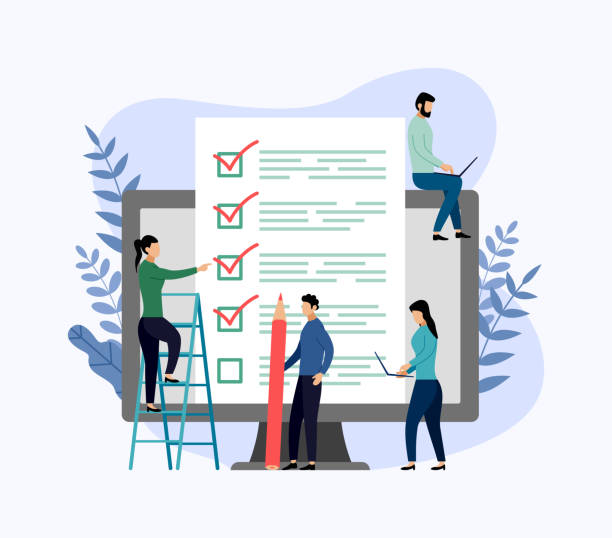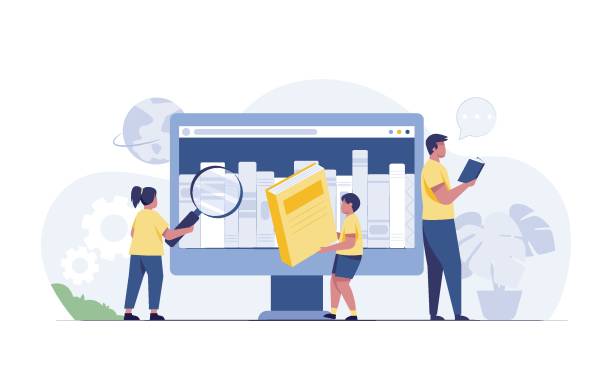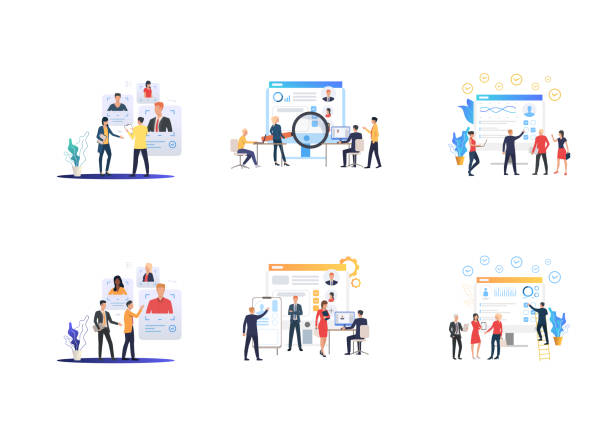Introduction to User-Friendly Website Design and Its Importance

In today’s world, where the internet has become an inseparable part of our daily lives, merely having a website is not enough.
What matters is the user experience that visitors receive from your site.
User-friendly website design goes beyond aesthetic appeal; this concept means creating a digital space where every user, regardless of their technical knowledge level, can easily interact with it and fulfill their needs.
Therefore, #ease_of_use, #accessibility, and #efficiency are considered the main pillars of a successful website.
If a site is not easy to navigate or if required information is hard to find, users will quickly leave it.
This early departure not only negatively impacts the #conversion_rate of visitors to customers but can also lower your site’s ranking in search engines.
Therefore, investing in a user-friendly website design is, in fact, an investment in the long-term success of your business.
This section provides an explanatory perspective to familiarize readers with the basic concepts of this field.
Next, we will delve into the various dimensions and fundamental principles of this type of design and offer practical educational tips.
The main goal of this section is to illuminate the path for a deeper understanding of why and how to create exceptional user experiences.
Do you dream of a thriving online store but don’t know where to start?
RasaWeb is your comprehensive solution for e-commerce website design.
✅ Attractive and user-friendly design
✅ Increased sales and revenue⚡ Get a free consultation
Why is User Experience (UX) Crucial for Website Success?

Have you ever wondered why you like some websites and visit them frequently, while you quickly leave others? The answer often lies in the quality of their User Experience (UX).
In today’s highly competitive world, where thousands of similar websites are accessible with just one click, providing a superior UX is no longer a luxury, but an absolute necessity.
This section analytically addresses the intriguing question of why user-friendly website design and focusing on UX are so vital.
Good UX means reducing friction for users; that is, they can effortlessly achieve their goals, whether it’s purchasing a product, finding information, or filling out a form.
When a site is well-designed and users can navigate it easily, their trust is gained, and their likelihood of returning increases.
From a business perspective, an excellent UX directly impacts the conversion rate, reduces the bounce rate, and increases the user’s time on site.
A website that frustrates its users not only loses potential customers but may also eventually be penalized by search engines.
Google’s algorithms are increasingly paying attention to user behavioral signals, such as time spent on site and bounce rate.
This means that if your site is not user-friendly, even if you have excellent content, you might not achieve a good ranking in search results.
Therefore, user-friendly website design is no longer just a design approach, but a business strategy that can determine survival and growth in the digital market.
This involves a deep understanding of user needs and expectations, and then designing solutions that best meet those needs.
This approach ensures that every visitor has a positive and flawless experience.
Key Principles in User Interface (UI) Design for Ease of Use

In conjunction with User Experience (UX), User Interface (UI) design plays a crucial role in determining how users interact with a website.
UI refers to all visual and interactive elements that users encounter; from buttons and forms to page layouts and colors.
To achieve a user-friendly website design, adherence to specialized and guidance-oriented principles in UI design is essential.
These principles include simplicity, consistency, visual feedback, and predictability.
Simplicity and Clarity: The UI should be as simple and understandable as possible.
Avoid clutter and unnecessary elements that distract the user.
Every element should have a clear purpose.
Consistency and Harmony: All design elements across the site should maintain a consistent visual style and language.
This helps users feel familiar and navigate easily from one page to another.
For example, Call-to-Action (CTA) buttons should appear consistently across all pages.
Visual Feedback: Users should receive feedback after every action they perform.
For instance, after clicking a button, there should be a color change or a small animation to inform the user that their action has been registered.
Predictability: UI elements should have predictable functionality.
Users should be able to anticipate what will happen when they click an icon or a link.
This increases trust and reduces confusion.
Accessibility: The design must be accessible to all users, including individuals with disabilities.
Using high-contrast colors, text labels for images (Alt Text), and keyboard navigation are important aspects of this section.
In the table below, some of the key UI features that contribute to user-friendly website design are mentioned:
| UI Feature | Description | Practical Example |
|---|---|---|
| Clear and Simple Navigation | Transparent and hierarchical menus that easily guide the user. | Top-page menus, sidebar with clear categories. |
| Visual Hierarchy | Using size, color, and white space to guide the user’s eye to important information. | Larger titles for headings, more prominent primary buttons. |
| Responsive Design | Automatic adaptation of site layout to various screen sizes. | The site displays correctly on mobile, tablet, and desktop. |
| Sufficient White Space | Using empty space around elements to reduce clutter and increase readability. | Appropriate spacing between paragraphs and images. |
| Efficient Search Capability | A prominent and efficient search box for quick content retrieval. | Search icon at the top of the page, filterable results. |
Adhering to these principles in user-friendly website design not only contributes to aesthetic appeal but also significantly enhances user efficiency and satisfaction.
The Importance of Responsive Design in Today’s World

Given the increasing use of various devices to access the internet, from mobile phones and tablets to laptops and smart TVs, Responsive Design is no longer an optional feature but an undeniable necessity for any user-friendly website design.
This section reports and specializes in the importance of this design approach.
Responsive design ensures that your website displays correctly, regardless of the screen size of the device used, providing a seamless and optimized user experience.
This means that content, images, and the layout of site elements automatically adjust to provide the best viewing and interaction on any device.
The absence of a responsive design can severely harm the user experience.
Imagine a user who accesses your site on their mobile phone, having to constantly zoom in and scroll horizontally to read text or click buttons.
This unpleasant experience quickly leads to site abandonment and user frustration.
On the other hand, search engines like Google prioritize responsive websites.
Google has explicitly stated that mobile-friendly websites rank better in mobile search results.
This news means for businesses that ignoring responsive design can lead to losing a significant portion of organic traffic.
Furthermore, maintaining a responsive website is much easier than having separate versions for desktop and mobile.
With a single codebase, content or design updates will only be needed in one place, saving time and cost.
Also, data analysis to understand user behavior will be simpler, as all data is collected from a single source.
In summary, a user-friendly website design in the current era must be responsive to meet the diverse needs of users, while also helping improve SEO and reduce maintenance costs.
This aspect of web design not only serves users but also significantly contributes to business success in the online space.
Does your current website inspire the trust that potential customers should have in your business?
If the answer is no, it’s time to have your professional and impactful corporate website with RasaWeb.
✅ Fully customized design tailored to your brand identity
✅ Increased lead generation and business credibility in the eyes of customers⚡ Contact us for a free consultation!
Website Loading Speed and Its Impact on User Experience

In today’s fast-paced world, the patience of internet users is diminishing.
No one likes to wait more than a few seconds for a website to load.
Website loading speed is one of the most critical factors in user-friendly website design, directly impacting User Experience (UX), conversion rates, and even search engine rankings.
This section analytically and guidance-oriented addresses the importance of this topic.
Research has shown that even a one-second delay in page loading can reduce conversion rates by up to 7% and severely impact customer satisfaction.
Why is speed important? Firstly, today’s users expect to receive information quickly.
If your site is slow, users will leave it without hesitation and go to your competitors.
This is especially critical on mobile devices, which may have more limited internet speeds.
Secondly, search engines like Google consider page loading speed as a ranking factor.
Faster websites offer a better user experience and, consequently, are more likely to rank higher in search results.
This means that user-friendly website design also requires speed optimization.
To improve site loading speed, there are several specialized strategies:
- Image Optimization: Images consume a significant amount of bandwidth.
Using appropriate image formats (like WebP), compressing images without quality loss, and lazy loading can significantly improve speed. - Reduce HTTP Requests: Each time the browser requests a file (image, CSS, JavaScript) from the server, time is spent.
These requests can be reduced by combining CSS and JS files and minimizing the number of elements on the page. - Use a CDN (Content Delivery Network): CDNs store your website’s content on various servers worldwide, so content is delivered from the server closest to the user, which increases loading speed.
- Optimize CSS and JavaScript Code: Removing unnecessary code, minifying, and placing CSS codes at the beginning of the page and JavaScript codes at the end of the page (to prioritize loading of main content) are very important.
- Choose Appropriate Hosting: A high-quality hosting service and high-speed servers play a fundamental role in server response time and, consequently, overall site speed.
By implementing these solutions, you can ensure that your website is not only visually appealing but also loads quickly and provides a flawless user experience for visitors.
This aspect of user-friendly website design is the most vital step for retaining users on your site and improving SEO.
The Importance of Useful and Engaging Content in User Acquisition

Content is king; this old adage still holds true in the digital world, especially when it comes to user-friendly website design.
Having a beautiful design and fast performance without valuable content is like a beautiful library without books.
This section educationally and expertly addresses the importance of producing useful and engaging content in attracting and retaining users.
Your content should meet users’ informational needs, answer their questions, and guide them toward achieving their goals on the site.
Relevant and High-Quality Content: Your content must be relevant to your site’s activity domain and appeal to your target audience.
Ensure the quality of writing and accuracy of information.
Poor or irrelevant content can quickly bore users and drive them away from your site.
Readability and Organization: Even the best content will not be effective if it’s difficult to read.
Use short paragraphs, subheadings, lists, and images to enhance readability and content organization.
A user-friendly website design places great importance on content layout so that users can quickly find the information they need.
Visual Content: Images, videos, infographics, and charts can help in better understanding content and make it more engaging.
Use high-quality images relevant to the text.
Call to Action: Your content should encourage users to perform a specific action (such as purchasing a product, subscribing to a newsletter, or contacting).
Call-to-action buttons should be clear and prominent.
Continuous Updates: Your site’s content should not remain static.
Regular content updates are not only beneficial for users but also indicate to search engines that your site is active and dynamic.
This can also help improve SEO rankings.
Next, the table below examines different types of content and their impact on user-friendly website design:
| Content Type | Purpose and Impact | Examples |
|---|---|---|
| Blog Content (Articles) | Education, information, building credibility, attracting SEO traffic. | “How-to…” articles, guides, reviews. |
| Product/Service Pages | Providing accurate information, encouraging purchases, answering FAQs. | Product descriptions, technical specifications, customer reviews. |
| Video and Podcast | Increased engagement, explaining complex concepts, entertainment. | Video tutorials, interviews, product introductions. |
| Infographic | Visually representing complex data in an understandable way. | Statistics, process steps, comparisons. |
| Customer Reviews/Case Studies | Building trust, proving value, encouraging conversion. | Testimonials, customer satisfaction videos, success stories. |
By combining a strong content strategy with an attractive visual design and flawless functionality, you can create an outstanding user experience that not only attracts users but also converts them into loyal customers.
The Role of Accessibility in Website Design for Everyone

One of the most important, yet sometimes overlooked, aspects of user-friendly website design is Accessibility.
Accessibility means that your website should be usable by all individuals, regardless of their abilities or disabilities.
This includes individuals with visual, auditory, motor, cognitive, and other impairments.
This section guides and specializes in the importance and implementation of accessibility.
Web Content Accessibility Guidelines (WCAG) have been developed by the World Wide Web Consortium (W3C) and provide a set of guidelines for building accessible websites.
Why is accessibility important?
- Inclusivity and Ethics: An inclusive society means that all individuals can access online information and services.
Designing an accessible website is an ethical and social responsibility. - Wider Audience Reach: It is estimated that a significant portion of the population has some form of disability.
By designing accessibly, you significantly expand your target market and create new business opportunities. - SEO Boost: Many accessibility optimization practices (such as using alt text for images, semantic HTML structure, and clear navigation) directly contribute to improving SEO.
Search engines can better understand and index accessible content. - Competitive Advantage: Websites that prioritize accessibility can differentiate themselves from competitors and demonstrate their commitment to their customers.
Solutions for implementing accessibility in user-friendly website design:
- Alt Text for Images: Provide a descriptive alt text for each image so that blind users who use screen readers can understand the image’s content.
- Use Semantic HTML Tags: Instead of using `div` for everything, use semantic tags like `header`, `nav`, `main`, `footer`, and `article` to make the page structure understandable for screen readers.
- Keyboard Control: Ensure that all site functions, including navigation, forms, and buttons, are controllable solely using the keyboard.
- Sufficient Color Contrast: Text and background should have sufficient color contrast to be readable for individuals with low vision.
Many online tools are available for checking contrast. - Form Labeling: All form fields must have clear labels so that screen reader users know what each field is for.
- Captions for Videos: Provide captions or text transcripts for video content so that individuals with hearing impairments can follow the content.
By implementing these principles, you not only help the community but also expand your user base and create a truly user-friendly and inclusive website.
Analyzing User Behavior for Continuous Optimization

After launching a website with a user-friendly website design, your work doesn’t end; it only begins.
To ensure your site continues to perform optimally and provide an enhanced user experience, continuous analysis of user behavior is essential.
This section educationally and analytically addresses how to use data for continuous website optimization and improvement.
Tools such as Google Analytics, heatmaps, user session recordings, and surveys can provide valuable insights into how users interact with your site.
Key Metrics for Monitoring:
- Bounce Rate: The percentage of users who leave the site after viewing one page without further interaction.
A high bounce rate can indicate irrelevant content or a poor user experience. - Average Time on Page/Site: Shows how long users stay on your site.
Longer time usually indicates more engagement and interest in the content. - Conversion Rate: The percentage of users who complete a desired action (e.g., purchase, sign-up, or download).
This is the most important metric for evaluating site success. - Navigation Paths: Examining how users move through your site, which pages they visit most, and where they leave the site.
This information can help improve navigation structure. - Heatmaps: These tools show where users click, scroll, or hover their mouse most on a page, providing visual insights into the popularity and interaction of various elements.
- Session Recordings: Watching recorded actual user interactions with the site can reveal pain points and usability issues that may not be evident through numerical data.
By collecting and analyzing this data, you can make data-driven decisions to improve your site.
For example, if you notice that users are abandoning the site at a specific stage of the purchase process, you can review and optimize that stage.
This continuous improvement process, also known as Conversion Rate Optimization (CRO), is a key element in maintaining a user-friendly website design over time.
This approach helps you always keep pace with the evolving needs and expectations of your users and ensures that your site always operates at its peak efficiency.
Does your current website inspire the trust that potential customers should have in your business?
If the answer is no, it’s time to have your professional and impactful corporate website with RasaWeb.
✅ Fully customized design tailored to your brand identity
✅ Increased lead generation and business credibility in the eyes of customers⚡ Contact us for a free consultation!
Website Security and User Trust

Alongside all visual and functional aspects, website security is one of the most vital pillars of a user-friendly website design that directly impacts user trust.
Today’s users are highly concerned about their privacy and data security, and if they feel insecure, they will quickly leave your site.
This section guides and specializes in the importance of website security and how to build user trust.
SSL certificates, protection against cyberattacks, and data privacy are among the issues that must be carefully considered.
Importance of SSL Certificate (HTTPS): One of the first and most fundamental steps to creating a secure website is installing an SSL certificate.
This certificate encrypts traffic between the user’s browser and the website server, preventing data interception or manipulation by third parties.
The presence of a green padlock icon in the browser’s address bar and the HTTPS prefix assures users that their connection to the site is secure.
Google also prefers HTTPS-enabled websites in search rankings.
Data Privacy (GDPR and CCPA): With increasing concerns about privacy, strict laws such as GDPR in Europe and CCPA in California have been enacted.
Your website must have complete transparency regarding how user data is collected, stored, and used.
Providing a clear and accessible privacy policy for users is essential.
Protection Against Cyberattacks: Websites are always vulnerable to various attacks such as SQL injection, Cross-Site Scripting (XSS), and Distributed Denial of Service (DDoS) attacks.
Using Web Application Firewalls (WAF), regularly updating Content Management Systems (CMS) and plugins, and frequent data backups are important measures for site protection.
Strong Authentication: If your site has sections that require user login, you must implement a strong authentication system (such as complex passwords, two-factor authentication).
The table below highlights some security measures that help increase user trust:
| Security Measure | Description | Impact on User Trust |
|---|---|---|
| SSL Certificate Installation | Encrypts information and displays HTTPS in the address bar. | Feeling of security in exchanging sensitive information (passwords, bank cards). |
| Clear Privacy Policy | Transparency in how data is collected and used. | Assurance against misuse of personal information. |
| Two-Factor Authentication (2FA) System | Adding another security layer for login. | Greater sense of confidence in protecting user accounts. |
| Regular Data Backup | Ability to restore information in case of issues. | Reduced concern over losing important information. |
| Transparent Security Notifications | Notifying about security updates or potential issues. | Feeling that the site cares about user security. |
By implementing these measures, you not only protect your website from threats but also build a strong foundation of trust with your users, which is essential for the long-term success of any user-friendly website design.
The Importance of Testability and Iteration in the Design Process

User-friendly website design is not a static process, but a dynamic and continuous cycle that requires testability and iteration.
Even the best designers cannot create a perfectly flawless website that is ideal for all users on the first attempt.
This section educationally and analytically addresses the importance of usability testing and the iteration process in continuously improving the user experience.
Usability Testing allows you to identify hidden weaknesses and problems by observing real users interacting with the site.
Why is testability essential?
- Identify Real Problems: Sometimes usability issues only become apparent during actual interaction with users.
What seems clear to a designer might be confusing to a user. - Validate Assumptions: Testing helps you confirm or refute your assumptions about how users will use the site.
- Reduce Long-Term Costs: Identifying and resolving problems in the early stages of design, is much cheaper than fixing them after the site is fully launched.
- Increase User Satisfaction: By continuously optimizing based on real feedback, you can significantly increase user satisfaction.
Steps in the Iteration Process for User-Friendly Website Design:
1. Initial Design: Based on initial research and user needs, create a preliminary design or prototype.
2. Test: Invite real users to perform specific tasks on the site and observe their behavior.
Ask open-ended questions and collect qualitative and quantitative feedback.
3. Analyze Data: Analyze the data collected from tests (such as pain points, confusing paths, task completion times) to identify patterns and core problems.
4. Refine: Based on the analyses, implement necessary changes in the design.
These changes can include redesigning parts of the UI, altering text, or simplifying workflow.
5. Iterate: After implementing changes, return to the testing phase and repeat the process.
This cycle continues until an optimal and flawless user experience is achieved.
This iterative approach allows you to continuously refine your design and ensure that your site always responds to the evolving needs of users.
User-friendly website design is not a destination, but a journey, and testing and iteration are the roadmap for this journey.
By embracing this philosophy, you can create a website that not only meets expectations but exceeds them.
Frequently Asked Questions
And other services of RasaWeb advertising agency in the field of advertising
Smart Website Development: An innovative service to enhance campaign management through key page optimization.
Smart Google Ads: An innovative service to improve SEO ranking through precise audience targeting.
Smart Marketplace: Designed for businesses seeking to increase click-through rates through precise audience targeting.
Smart Sales Automation: An effective tool to boost sales with the help of Google Ads management.
Smart Conversion Rate Optimization: A dedicated service for growing user engagement based on Google Ads management.
And over a hundred other services in the field of internet advertising, advertising consulting, and organizational solutions
Internet Advertising | Advertising Strategy | Advertorials
Resources
User-Friendly Website Design Guide on Virgool
UI/UX Principles in Web Design from Ali Team
SibWeb Articles: Successful Website Design
The Impact of Website Design on Digital Marketing by Pishkesvat
? To shine in the digital world and reach the pinnacle of success, RasaWeb Afarin Digital Marketing Agency, by providing comprehensive services including professional website design and SEO, is with you to elevate your business to the position it deserves.
📍 Tehran, Mirdamad Street, next to Bank Markazi, Southern Kazeroon Alley, Ramin Alley, No. 6


